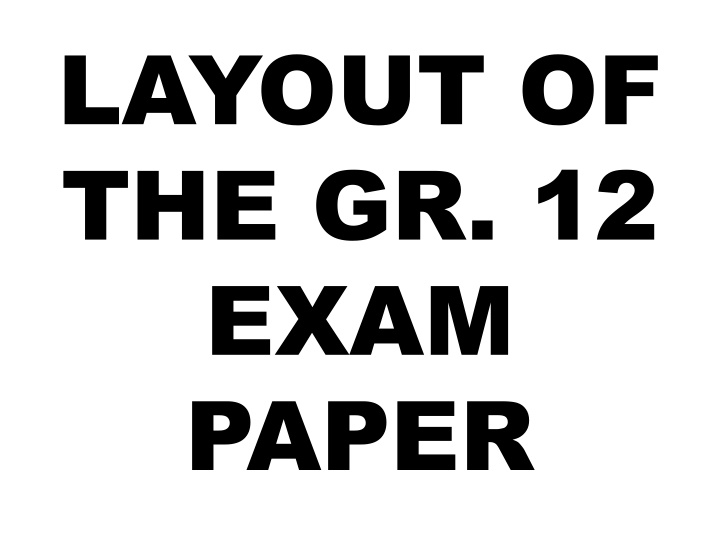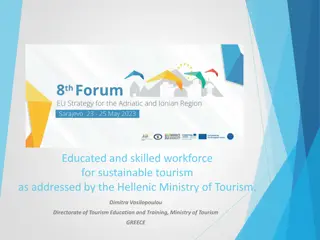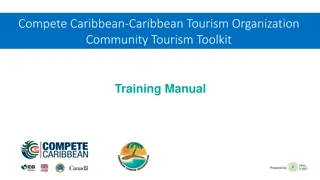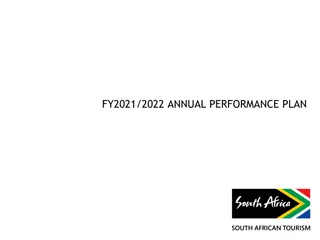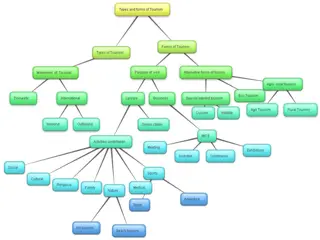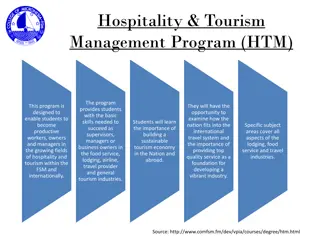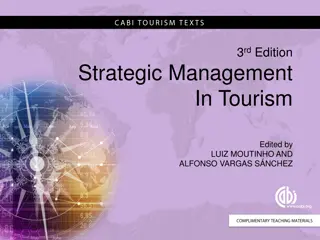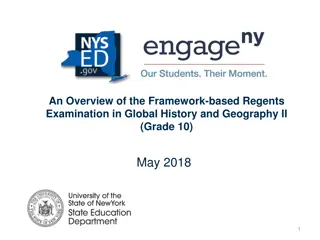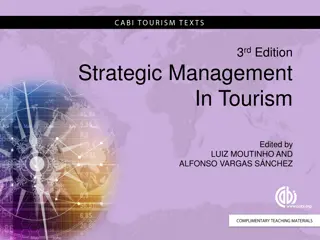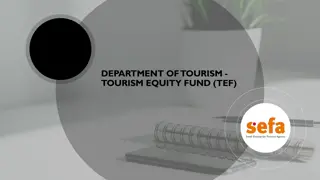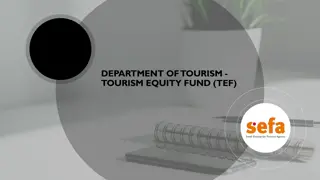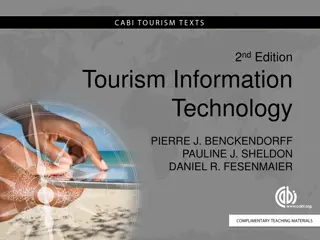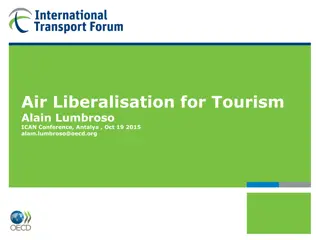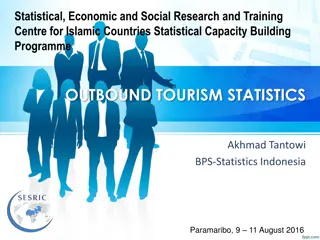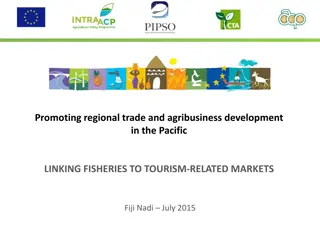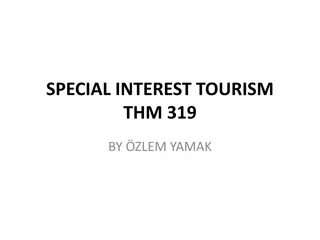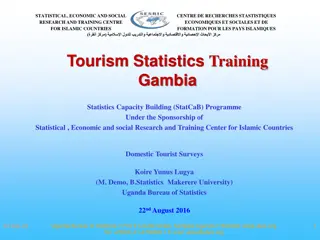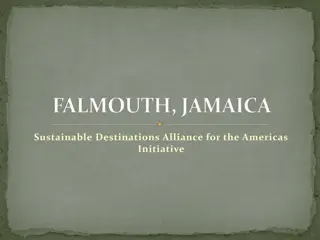Grade 12 Tourism Exam Paper Overview
The Grade 12 Tourism exam paper consists of a 3-hour test divided into five compulsory sections covering various topics such as tourism attractions, marketing, sustainable tourism, and more. Learner tips include reading instructions carefully and utilizing resources like case studies and maps. Section A focuses on short questions testing knowledge of tourism terminology and concepts. Prepare effectively for each section to excel in the examination.
Download Presentation

Please find below an Image/Link to download the presentation.
The content on the website is provided AS IS for your information and personal use only. It may not be sold, licensed, or shared on other websites without obtaining consent from the author.If you encounter any issues during the download, it is possible that the publisher has removed the file from their server.
You are allowed to download the files provided on this website for personal or commercial use, subject to the condition that they are used lawfully. All files are the property of their respective owners.
The content on the website is provided AS IS for your information and personal use only. It may not be sold, licensed, or shared on other websites without obtaining consent from the author.
E N D
Presentation Transcript
LAYOUT OF THE GR. 12 EXAM PAPER
Format of the Paper The Tourism examination consists of one 3-hour paper of 200 marks. The question paper is divided into five COMPULSORY sections. All topics and subtopics in the Grade 12 CAPS will be assessed, however Grade 10 and 11 content will be considered foundational, underpinning knowledge.
The table below suggests how candidates' time should be spent in the Tourism examination room SECTION QUESTION TOPIC MARK S 40 MINUTE S 20 A 1 Short Questions (covering all topics) B 2 3 4 5 6 7 8 Map work and tour planning Foreign exchange Tourism attractions Cultural and Heritage Tourism Marketing Tourism sectors Sustainable and responsible tourism 50 50 C 50 50 D 30 30 E 9 Domestic, regional and international tourism 30 30 10 Communication and Customer Care
Learner Tips Read all the headings and instructions carefully. Learners should be prepared to engage resources such as case studies, extracts, graphs, maps, cartoons, pictures, etc. as application of the content is one of the skills required in Tourism. Study each resource, whether it is a cartoon, photograph, map, mind map, table, flow chart, graph or text and question: 'What is this about? What is it telling me? What part of my knowledge does it relate to?' Learners must be encouraged to read through the question paper carefully before they start writing. When learners are allowed to start writing, they should jot down any thoughts or ideas that that come to mind on certain questions at the back of the answer book. The jotting down of ideas can be useful memory triggers when they actually come to answer the questions.
SECTION A: SHORT QUESTIONS This section will contain short questions such as multiple-choice questions, matching questions (COLUMN A/COLUMN B), choose the correct word from the options given, give the correct term, map work, graphs, mind maps, pictures, tourism logos, cartoons, etc. There are no TRUE or FALSE questions. Know the Tourism terminology and acronyms well; it may be assessed in this section. Learners must be made aware that, contrary to popular belief, this section cannot necessarily be considered the 'easy' part of the paper. Questions which at first glance appear simple may require careful consideration. Give this section the time it deserves. All topics and subtopics in the Grade 12 CAPS may be assessed in this section, however Grade 10 and 11 content considered foundational, underpinning knowledge may be included here. Tourism does NOT use answer sheet templates for this section. All answers must be written in the ANSWER BOOK provided.
SECTIONS B, C, D and E These sections assess individual topics in more depth and will in general require more comprehensive and in some cases, more in-depth responses from learners. In these sections questions may include sources such as maps, graphs, tables, pictures, logos, flow diagrams, extracts, case studies, cartoons, etc. It will be to the advantage of learners to be exposed to as many of these resources as possible in the internal formal assessment tasks. The paper will not only assess the learners' knowledge of the content in the topics, but also their ability to demonstrate more complex understanding. They may be asked to explain, motivate, substantiate, interpret, apply and reason. Questions may start with 'Give your views on ', 'Explain why ' , 'Discuss how ', 'Comment on ...', 'Suggest ...', 'Analyse ...', 'Evaluate ...', 'Do you agree ' etc. These questions require higher order thinking skills and learners have to think critically and creatively or solve problems. Refer to examples on page 7 & 8. These sections will also include questions that require paragraph-type responses. It is advisable to expose learners to a variety of the different types of paragraphs and prepare them accordingly.
Cognitive demand in the paper The paper caters for a range of cognitive levels and the different learning abilities of learners. Candidates can expect questions of a lower, middle and higher cognitive level. Questions of a lower and middle cognitive level are indicated by action verbs such as 'name', 'give', 'identify', 'describe', 'list', 'match', 'explain', 'calculate', 'interpret', etc. Higher- order skills are indicated by action verbs such as 'compare', 'contrast', 'discuss', 'differentiate', 'analyse', 'evaluate', etc. To adequately prepare learners for the cognitive demands of the final examination paper, it is essential for teachers to align cognitive demand of all internal formal assessment tasks for Grades 10 12 to the levels stipulated in the CAPS. More complex learning will lead to higher order thinking. Teachers must ensure that internal formal assessment tasks not only contains the 'know what' but also the 'know how'.
The following table indicates the weighting of the cognitive demand in the paper as stipulated in the CAPS: COGNITIVE LEVELS % MARKS Lower order: remembering 30 60 Middle order: understanding and applying 50 100 Higher order: analysing, evaluating and creating 20 40 Teachers, learners and parents must note that there is usually a relation between the marks allocated for a particular question and the cognitive demand. Learners should keep this in mind when responding to questions.
THE CONTENT FOR GRADE 12 (CAPS) SECTION A: SHORT QUESTIONS 40 marks Questions in this section will assess content on knowledge, comprehension and application.
SECTION B: (2 questions) 50 marks Learners will need non-programmable calculators for this section. QUESTION 2: MAP WORK AND TOUR PLANNING Candidates can expect questions on the following: Tour plans and route planning, compiling a day-by-day itinerary, compiling a tour budget, health, safety, travel documentation, world time zones and calculations of world times when travelling between countries. General comments: No coordinates will be given for calculating time. A time zone map will be provided to determine coordinates. It is advisable that teachers expose learners to the time zone map used by examiners in the national paper Learners are not required to know which countries apply DST, however from the given scenario/table be able to determine whether to apply DST. Understanding the implication of adjusting the clocks backward and forward and the reasons for this, is important. Learners must show all calculations. Marks will be allocated for correct calculations in the steps preceding the final incorrect answer.
SECTION B: (2 questions) 50 marks Learners will need non-programmable calculators for this section. QUESTION 3:FOREIGN EXCHANGE Candidates can expect questions on the following: Foreign exchange General comments: Impacts of the fluctuation of the rand against major currencies. Use only exchange rates expressed as 1 unit of foreign currency = value in rand, i.e. 1USD = R7,60. Calculators may be used for calculations rounded off to two decimals, e.g. R34,56. Learners must show all calculations. If no instruction is given in the scenario, learners must know when to use the BSR and BBR when doing the calculations. Know the reasons for the fluctuations in exchange rates.
SECTION C: (3 questions) 50 marks QUESTION 4: TOURISM ATTRACTIONS Candidates can expect questions on the following: Famous world icons and attractions. General comments: Candidates are required to distinguish between an attraction and an icon and to interpret and evaluate the latest statistics presented in the form of graphs and tables. Candidates can expect to be assessed on the location of icons/attractions on a world map (country, city/town/area), reason/s why is it an icon/attraction and a brief description of the icon/attraction. Teachers must ensure that candidates are exposed to visuals of icons/attractions in addition to the theoretical facts.
SECTION C: (3 questions) 50 marks QUESTION 5: CULTURE AND HERITAGE TOURISM Candidates can expect questions on the following: World Heritage Sites General comments: Candidates must be able (among others) to give a description of all the World Heritage Sites in South Africa, their location on a map of South Africa, and how they meet UNESCO criteria using latest information. They have to be able to recognise the logo, know the main function and role of UNESCO. Teachers must ensure that the latest,
SECTION C: (3 questions) 50 marks QUESTION 6: MARKETING Candidates can expect questions on the following: Marketing South Africa as a tourism destination General comments: Learners should understand the concepts: core markets; investment markets; tactical markets; watch list markets; strategic importance of trade/investment; strategic links/hubs and how these concepts relate to marketing South Africa as a tourism destination.
SECTION D: (2 questions) 30 marks QUESTION 7: TOURISM SECTORS Candidates can expect questions on the following: Professional image in the tourism industry, conditions of employment and the purpose and value of a code of conduct General comments: The examiners may give an extract and candidates may be required to interpret and apply the information. It is not a requirement for the learners to memorise any legislation.
SECTION D: (2 questions) 30 marks QUESTION 8: SUSTAINABLE AND RESPONSIBLE TOURISM Candidates can expect questions on the following: The three pillars of sustainable tourism, Corporate Social Investment (CSI) in tourism, Responsible tourism and tourists. General comments: The three pillars of sustainable tourism is a challenging topic. It is therefore crucial that the groundwork, i.e. all the terminology and concepts associated with this section that was taught in Grade 10, be thoroughly revised and reinforced. Candidates have to demonstrate understanding of the concept and background of the triple bottom line approach. Expose learners to case studies
SECTION E: (2 questions) 30 marks QUESTION 9: DOMESTIC, REGIONAL AND INTERNATIONAL TOURISM Candidates can expect questions on the following: Global events of international significance, political situations and unforeseen occurrences of international significance, forms of payment when travelling internationally, foreign market share statistics regarding inbound international tourism.
SECTION E: (2 questions) 30 marks QUESTION 9: DOMESTIC, REGIONAL AND INTERNATIONAL TOURISM General comments: Only examples of global events of international significance are required. Learners are not required to study the events as such. Leaners should be able to deduce the impact these events have on tourism (domestic, regional and international). Recent information should be accessed from the media. Candidates are not required to study the political situations and unforeseen occurrences as such. Focus on the impact these situations and occurrences have on international tourism and the economy of the affected country. It is important to make sure learners are aware of recent examples. Foreign market share and statistics: Learners have to know key concepts such as inbound tourists/foreign market share/core markets/new markets/existing markets/ source markets/tourist arrivals/emerging markets. When assessing tourism arrival statistics to determine foreign market share, learners may be expected to interpret graphs and statistical information on countries of origin,
QUESTION 10: COMMUNICATION AND CUSTOMER CARE Candidates can expect questions on the following: Methods to obtain customer feedback and to measure customer satisfaction. General comments: Learners may be required to interpret and apply information from extracts, pictures or cartoons. (Exam instructions 2014)
